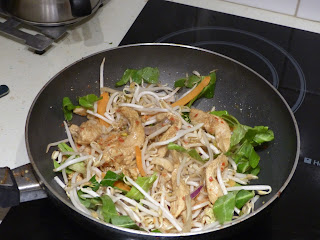How to roast a chicken with a lemon up its bum.
Here is a picture of most of the things you will need:
Again, any cats seen are surplus to requirement.
Heat the oven while you assemble your bird. You probably need a moderately high heat, so 190 - 200 degrees celsius.
Here's the list:
- One medium chicken
- One lemon
- One bulb of garlic, separated into cloves and peeled
- Salt
- Pepper
- Various vegetables sliced so that they can make a layer for the chicken to sit on. I used three small carrots, two sticks of celery and a red onion sliced through with slices at about 0.7 cm thickness
- Rosemary if you have it or a herb of your choice. I had intended to use thyme
- Streaky bacon
- Butter - around 50 g
- Olive Oil
First, use about a tablespoon of olive oil and use a brush or your fingers to make sure that the inside of the roasting tin is covered. Then add the vegetables to make a bed to sit your chicken on. Here's mine:
Add about a tablespoon of salt to the cavity of the chicken (take out any giblets first and save them for something else), turning the chicken around so that the salt is evenly distributed. Put a few cloves of garlic into the cavity, then the lemon (piercing it through with a sharp knife first) and then the rest of the cloves of garlic, pushing a few around the sides of the lemon.
This would be where you would add herbs to the cavity if you remember. I forgot. In the end I shook about a tablespoon of thyme and some pirpiri season (birdseye chillies and lemon) over it.
Put the chicken in the roasting pan and, using your hands, lift the skin from the breast side and shove a knob of warm room temperature butter under the skin between the skin and the flesh. You may have to break a membrane near the bum end. Massage the butter so that it is spread out over the chicken. Your chicken will look like this:
Try and get the butter distributed as evenly as possible and smear a little on the thighs.
Now cover the chicken with streaky bacon.
If you have one, use a wooden cocktail stick to pin the parson's nose into place and kitchen twine to bind the legs together but if you don't have these things, don't worry.
Put it in the oven for an hour or so (look up the times for a bird your size) and forget about it. If you want, you can take it out and baste it, and maybe upend the chicken a bit so that some of the juices come out to baste the vegetables, but you don't need to.
The best way to tell if a chicken is cooked is to use a meat thermometer and stick it down the thickest part of the drumstick - you want your baby to get to at least 165 /70 deg celsius. It should be near there after an hour.
If the bacon is now crispy, take it off. If it isn't crispy, give it an extra ten minutes. You can eat it wiht a glass of wine as an aperitif. Baste the chicken with the juices in the pan - you may have to tilt it to get the juices coming out.
Once the bacon is off, turn the temperature up to 220 degrees celsius and put the chicken back for 20 minutes to half an hour, so that the skin is golden. Mine looked like this when I eventually took it out:
Get it out of the tray and onto a plate and cover it with foil, letting it reabsorb all the juices, for fifteen minutes - half an hour.
Meanwhile, make the gravy. Your pan should look like this, with some of the vegetables charred (hopefully).
Try one of the carrots - it should taste AMAZING. The juices in the pan are a combination of bacon fat, chicken fat, butter and lemon juice. You are going to add chicken stock and flour.
Heating the pan on medium over one or two hobs (if the hobs are close enough or the roasting pan big enough), sprinkle in a heaped teaspoon of ordinary plain flour. Not cornflour, flour. Stir and mash this continally until the flour has been bubbling for about a minute.
Add about 300 - 500 ml of chicken stock slowly, and continually stir until the juice-soaked flour is incorporated. Heat until it bubbles for a minute. Voila, gravy.
You can pass the gravy through a sieve and I would, if I had company.


















































